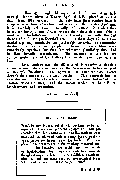
Reading through old copies of A.S.F., one often finds nostalgic letters about a 'Golden Age' of S.F., placed at various dates from 1928 onwards. The only thing these readers have in common is a firm conviction that whenever the 'Golden Age' was, it is certainly not now. Actually, of course, it is when they began reading S.F., and if they retrace their steps they are liable to meet with disillusionment. This is specially true with the first decade of S.F., the pre-Campbell era. In those days all an author needed was an improbable idea, preferably involving the spectacular demise of a few million people. Some of these ideas were remarkably ingenious, but they lost whatever plausibility they had by their juvenile presentation. The universe is just too big to be pushed around by Bulldog Drummonds, even one with a lens.
Later authors met the difficulty of introducing a plausible human interest into cosmic plots by the 'worm-eye' technique used in Hersey's Hiroshima, the apprisal of extra-ordinary events through their impact on ordinary people. This approach has its own dangers. The characters become the pawns instead of the masters of circumstance, and the stories tended to be full of bewilderment and frustration.
The atom war cycle has now ended, and from Campbell's experiments lately it seems we are in for another 'thought-variant' era. I hope he's not satisfied with the crop of corn which has resulted so far; surely the end is not Lafayette? The serials have been better, but parapsysics, the latest fashion among authors, dates back at least as far as Campbell's Forgetfulness. As for Dreadful Sanctuary, Russell's only new angle is the insert to S.F. of the Dashell Hammett detective story technique. Very readable, when done as well as Russell does it, but the interest of the story is extraneous to the science, and we may be in as much danger from space 'whodunits' as we were from space operas.
Won't be any bigger, but it will we hope be better, especially if we can get more equipment. When you consider that, for example, all the illustrations were produced on plywood with a razor blade, perhaps you'll agree we haven't done too badly. We have pland for improvements in the reading material, too.
Incidentally, we could run an article on book-binding for magazine collectors, and we thought it might be interesting to publish a questionnaire to find out what sort of psychological types S.F. Readers are. What do you think?
Data entry and page scans provided by Judy Bemis
Data entry by Judy Bemis
Updated December 11, 2017. If you have a comment about these web pages please send a note to the Fanac Webmaster. Thank you.